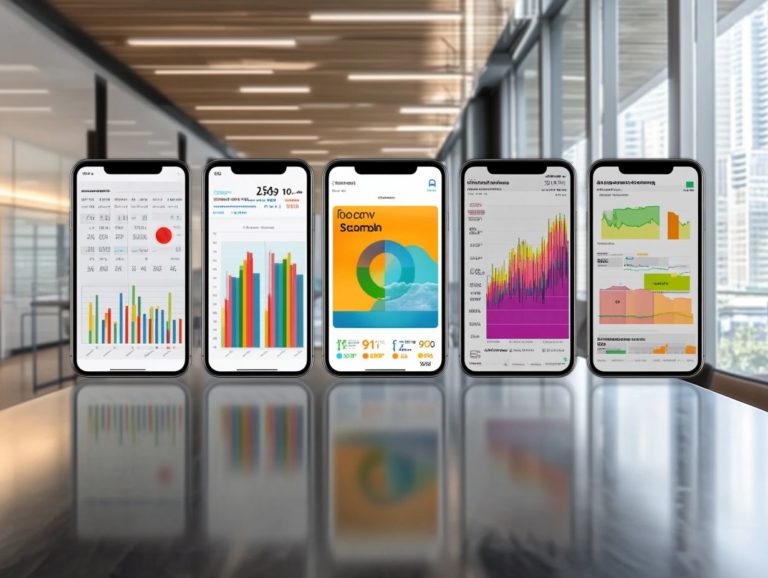Performance Management Tools and Employee Development
Understanding performance management is key for organizations that want to boost employee engagement and productivity. It shapes how you evaluate, develop, and guide employees toward their aspirations.
This discussion delves into the essence of performance management, highlighting its importance and key components such as goal setting, feedback, and appraisals. It examines various tools like performance dashboards and 360-degree feedback which elevate the entire process.
You ll discover best practices for effective implementation and the myriad benefits of employee development, including enhanced performance and engagement. Engage in this exploration to grasp the pathway to a motivated and high-performing workforce.
Contents
- Key Takeaways:
- Understanding Performance Management
- Key Elements of Performance Management
- Types of Performance Management Tools
- Effective Implementation of Performance Management Tools
- Benefits of Employee Development
- Frequently Asked Questions
- What are performance management tools?
- Why is employee development important for performance management?
- What types of performance management tools are available?
- How can performance management tools help with employee development?
- Can performance management tools be customized for different roles or departments?
- Are there any potential drawbacks to using performance management tools?
Key Takeaways:

- Use performance management tools to set clear goals and boost engagement.
- These tools provide valuable insights for effective evaluation and development planning.
- Proper implementation leads to improved employee performance, engagement, and retention, aiding succession planning.
Understanding Performance Management
Performance management involves setting clear objectives, providing continuous feedback, and conducting regular evaluations. This approach fosters a workforce that thrives on transparency and constructive appraisals, showcasing the benefits of using performance management tools.
It not only helps track goals but also offers invaluable insights into employee development and satisfaction, enabling you to adapt and fine-tune your processes for exceptional outcomes.
Definition and Importance
Performance management is a continuous journey that encompasses setting objectives, providing regular feedback, and evaluating performance with the help of performance management tools to nurture professional development.
This process is crucial because it aligns you with the organization s broad goals, ultimately fueling success and innovation. By embracing effective development strategies, businesses can create an environment where you feel valued and supported in your career path.
Regular feedback allows you to track your progress and take charge of your growth, enhancing engagement and productivity. Open communication helps you express your goals, allowing leaders to adjust objectives to better suit your needs.
As a result, you become part of a dynamic workforce, able to meet changing demands.
Key Elements of Performance Management
The key elements of performance management include goal setting, continuous feedback, structured appraisals, and development planning. Utilizing performance management tools for healthcare organizations can enhance each of these components, playing a vital role in creating a cohesive employee management strategy that drives success and fosters growth.
Goal Setting and Feedback
Goal setting and feedback are essential elements of performance management, enabling you to grasp your objectives and receive constructive insights on your progress.
By establishing clear, achievable goals, you create a roadmap for success, breaking down larger objectives into manageable tasks. Consider using the SMART criteria Specific, Measurable, Achievable, Relevant, Time-bound to formulate these goals effectively.
Timely and effective feedback is crucial for your growth. Tools like 360-degree feedback, where input is gathered from various coworkers, or regular check-in meetings can offer invaluable insights, fostering a culture of open communication. Techniques such as the Sandwich Method pairing positive feedback with constructive criticism can enhance engagement.
By implementing these strategies, you ll feel supported in your development, ultimately leading to improved performance outcomes.
Performance Appraisals
Performance appraisals are your opportunity to engage in structured evaluations of employee performance. They offer crucial ratings and insights that guide decisions about compensation and future development.
These evaluations highlight achievements and play a vital role in fostering transparency and accountability within your organization. When done thoughtfully, performance appraisals encourage open dialogue between you and your employees. This promotes constructive feedback that lays the groundwork for continuous improvement.
Implementing best practices such as setting clear performance criteria and incorporating 360-degree feedback, which gathers input from all levels allows for a more comprehensive assessment. By leveraging technology like performance management software, you can streamline the process and ensure that evaluations remain fair and unbiased. This ultimately enhances both organizational culture and employee morale.
Development Planning
Development planning is essential to performance management. It emphasizes the importance of aligning your growth with the organization s objectives through personalized learning and development opportunities.
By implementing comprehensive personal development strategies, you can cultivate a culture of continuous feedback that motivates you and enhances your skill set. This ongoing dialogue between you and your manager creates a supportive environment where you feel valued and engaged.
When you recognize that your growth is actively supported, you re more likely to take ownership of your performance. This leads to greater job satisfaction and productivity. Regular feedback enables you to adapt your efforts effectively, ensuring that your personal aspirations align seamlessly with broader organizational goals.
Types of Performance Management Tools

Explore a rich array of performance management tools designed to elevate HR processes, track employee performance, and boost engagement through cutting-edge software solutions.
Performance Dashboards and Scorecards
Performance dashboards and scorecards are essential tools for visualizing key performance metrics. They provide insights that enable knowledge-based decision-making and strategic planning.
By consolidating data from diverse sources, these platforms allow you to effectively monitor employee performance and ensure it aligns with your broader organizational goals. Usability is crucial; intuitive interfaces help you easily interpret metrics and trends, enhancing engagement and accountability.
Performance dashboards showcase individual contributions, while scorecards enable you to compare departmental achievements against established objectives. This multifaceted approach enhances transparency and nurtures a culture of continuous improvement, allowing your teams to adapt their strategies in real-time based on measurable outcomes.
360-Degree Feedback
360-degree feedback is a comprehensive evaluation process that gathers insights from various stakeholders. This approach offers you a well-rounded perspective on your performance.
This methodology includes input from peers, supervisors, and even subordinates, ensuring you receive a holistic view of your strengths and areas for improvement. By integrating diverse viewpoints, the process boosts your engagement and encourages continuous development. You ll be able to identify skill gaps and receive actionable recommendations, setting the stage for targeted growth initiatives.
This multifaceted approach enhances collaboration and trust within your teams, fostering a more cohesive work environment where everyone feels valued and motivated to strive for improvement.
What steps will you take to implement these performance management tools in your organization?
Employee Development Plans
Employee development plans are your strategic blueprint for crafting individual growth objectives. They outline the steps necessary to bring these objectives to fruition. These plans cultivate a culture of continuous improvement that benefits everyone involved.
They act as your personal roadmap while incorporating essential elements like skill assessments and performance reviews. This ensures that your progress is consistently tracked. By aligning your aspirations with broader organizational goals, you foster a cohesive atmosphere where both you and the company can flourish.
Effectively monitoring your objectives allows for timely feedback and adjustments. This keeps the development process relevant and impactful. In essence, these plans are crucial for nurturing your talent, opening doors to learning opportunities, and enhancing your job satisfaction. All of these contribute to a more engaged and motivated workforce.
Effective Implementation of Performance Management Tools
To implement performance management tools effectively, engage in careful planning and adhere to best practices. It’s essential to provide the right support to ensure that processes are not only streamlined but also advantageous for both employees and the organization as a whole, utilizing performance management tools: strategies for success.
Best Practices and Tips
Adopting best practices for performance management can significantly elevate your employee engagement and communication. This results in more effective feedback and performance reviews.
When you implement clear communication methods that prioritize regular check-ins, you enable your teams to share their concerns and celebrate their achievements. This approach ensures that your employees feel valued, fostering a culture where feedback transcends mere formality and becomes a powerful tool for growth.
Utilizing techniques like anonymous surveys allows you to capture genuine insights. This helps you understand areas for improvement without putting your employees on the spot. By embracing a cycle of continuous feedback instead of relying solely on annual reviews, you encourage your workforce to strive for excellence, creating an environment where both individuals and teams can thrive.
Benefits of Employee Development
The advantages of employee development reach far beyond personal advancement. They significantly enhance organizational engagement, retention, and overall productivity. By fostering a skilled and motivated workforce, you create an environment where both individuals and the organization thrive together.
Improved Performance and Engagement

Improved performance and engagement are direct outcomes of effective employee development initiatives. They foster a culture of satisfaction and productivity within your organization.
When you prioritize tailored training programs, mentorship opportunities, and continuous learning pathways, you create an environment that nurtures individual skills while strengthening team dynamics. Investing in professional growth sparks excitement and loyalty among your employees!
As your employees feel valued and enabled through these developmental efforts, they are more likely to contribute innovative ideas and demonstrate genuine commitment to their roles. This ultimately boosts overall productivity metrics across the board.
Retention and Succession Planning
Retention and succession planning are essential elements of talent management. They ensure you have a skilled workforce ready to step into leadership roles.
By prioritizing these strategies, you create a workforce that is not only stable but also highly engaged. This workforce is capable of adapting to the ever-evolving demands of the market.
Implementing effective employee development practices, such as customized training programs and mentorship opportunities, is crucial in helping future leaders grow. This proactive approach sharpens individual skill sets and aligns personal ambitions with your organizational goals, nurturing a culture of growth.
In doing so, you secure a robust talent pipeline and enhance your competitive edge. This ensures that your future leadership is well-prepared to navigate the complexities of tomorrow’s market.
Frequently Asked Questions
What are performance management tools?
Performance management tools are systems that help organizations track and improve employee performance. They can include employee reviews, goal setting, and development plans.
Why is employee development important for performance management?
Employee development is essential for performance management. Utilizing performance management tools helps workers gain new skills and improve existing ones.
What types of performance management tools are available?
Common types include employee reviews, feedback from various sources, goal tracking systems, and development plans. Many organizations also use software for these processes.
How can performance management tools help with employee development?
These tools provide insights into an employee’s strengths and improvement areas, supporting the creation of targeted development plans. For a more comprehensive understanding, explore performance management tools to build a better workforce.
Can performance management tools be customized for different roles or departments?
Yes, they can be tailored to meet the specific needs of different roles. This personalization makes development more effective.
Are there any potential drawbacks to using performance management tools?
While helpful, these tools may overly rely on data, which doesn’t always show the complete picture of performance. They might also reduce personal interaction.







